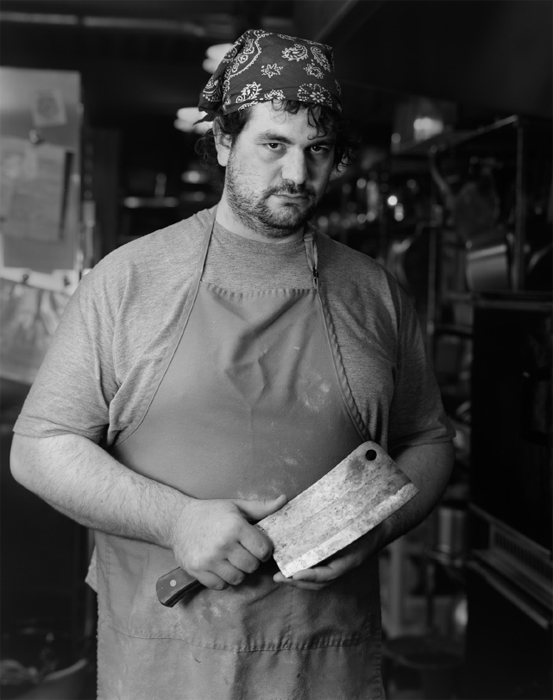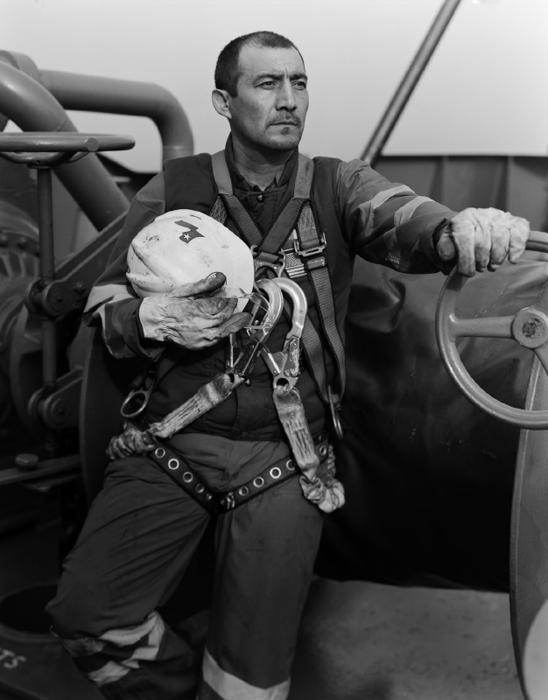|
'Antarctic Souls'Photographer Sternbach shoots portraits at Palmer StationPosted November 14, 2008
Scott Sternbach’s Only the Carhartts, the synthetic fleeces and the various modern accoutrements of his subjects break the illusion. These “heroic” portraits of scientists, cooks, mechanics, ship deckhands and others are the focus of Sternbach’s project called “Antarctic Souls.” Director of Photography at LaGuardia Community College in the City University of New York (CUNY) His environmental portraits — shot using an 8X10-view camera, the type usually only seen these days in Western movies — seek to capture archetypes. “I really find human beings in extreme circumstances to be of interest to me. How do they look? How are they different from people who might not be in this environment? How are they similar to people who might be in a different environment? Are these people interchangeable? Is the face of a cook in Antarctica similar to the face of cook in urban Jersey City, New Jersey? The answer is yes and no. They’re very similar and very different, too. “The face of a person is a reflection of the place they’re in if they’re there long enough,” he added during a phone interview about a month into the project. Sternbach shoots portraits as one would photograph landscapes — waiting for the scene to unfold naturally, like when dawn perfectly purples a mountaintop. “It’s like a human landscape almost,” he said. “I don’t elicit responses from people. I just let them do their thing. … I’m just trying to let them shine through. “It’s almost magical the way it happens sometimes.” The vintage Wisner 8X10 camera is well suited for the job, according to Sternbach, because of the slow and methodical process required to set it up and create an image. That time allows Sternbach and his subject to connect, an intimacy revealed in an expression frozen forever in black and white. The vintage camera is also a connection to the past. “The neat thing about it is that it’s almost exactly the same equipment used during Scott and Shackleton’s time, back in the turn-of-the-century, early explorations. That was my inspiration,” he said. The 8X10 format is technically ideal for portraits thanks to its shallow depth of field, sharpening the subject and softening the landscape. “The resolution is better than any camera known to man, pretty much. I get incredible resolution,” he explained. “The environment is there but it’s not as important as the person, so I love that aspect of the camera.” Sternbach started his journey to Antarctica in Punta Arenas, Chile, with his student and assistant Homero Campos. He broke out the vintage camera during the crossing of the Drake Passage aboard the ARSV Laurence M. Gould Since then, Sternbach has photographed most everyone at the station. He admits that he is attracted to some people more than others for his portraits. “There are just certain people who are just photogenic, interesting, or just show their life experience on their face,” he said. “Beyond that, some people have a look in their eyes, a certain depth in their eyes. I’m going to look for people who are very interesting, who show a lot in their visual appearance.” Photography is something of a family tradition, Sternbach said. He had his own darkroom by age 11 with equipment given to him from his grandfather, a civil rights lawyer who was an avid amateur photographer, with “a camera always dangling from his neck.” Sternbach also inherited his great-grandfather’s glass plate negatives from the early 1900s. “From 11 years old, I was a photographer. In school, I took all of the newspaper photos. I was the yearbook photographer,” he said. “It was a family thing and just sort of natural for me to go that route.” Sternbach’s work has ranged over a wide variety of subjects during his career. After school, he opened a studio in Manhattan, focused on the music industry. In recent years, he has hiked the backwoods of Delaware County to capture the lifestyle of small dairy farmers. He has documented the desolate sites of pre-war industrial ruins in and around New York City. And he has explored Jersey City’s poor neighborhood shops, churches and streets. For the “Antarctic Souls” project, Sternbach said his photographs are already being displayed around CUNY. He also plans to lecture throughout the university system, as well as at high schools in the metro area about his experience and the scientific importance of Antarctica. He hopes to produce a book eventually of his work as well. “I’m going to get it out there any way I can.” NSF-funded work in this story: Scott Sternbach, City University of New York La Guardia Community College, Award No. 0739800 |



For USAP Participants |
For The Public |
For Researchers and EducatorsContact UsU.S. National Science FoundationOffice of Polar Programs Geosciences Directorate 2415 Eisenhower Avenue, Suite W7100 Alexandria, VA 22314 Sign up for the NSF Office of Polar Programs newsletter and events. Feedback Form |







